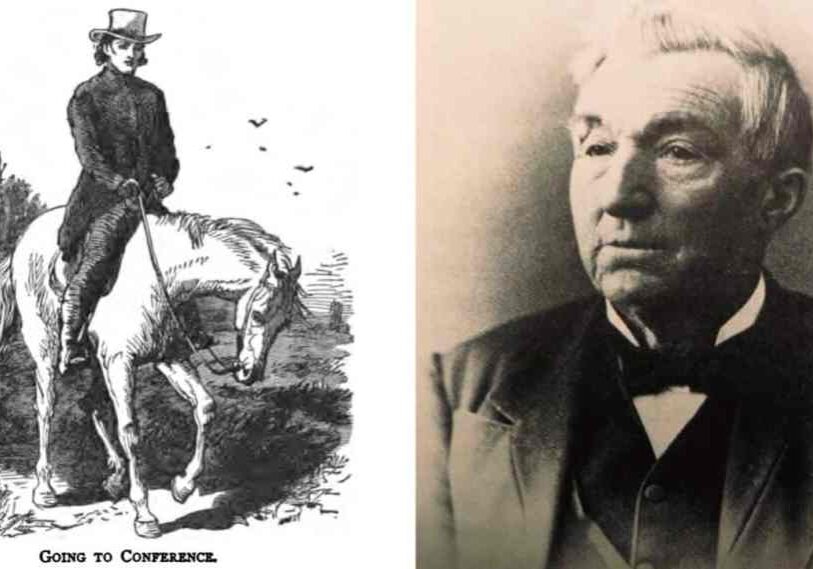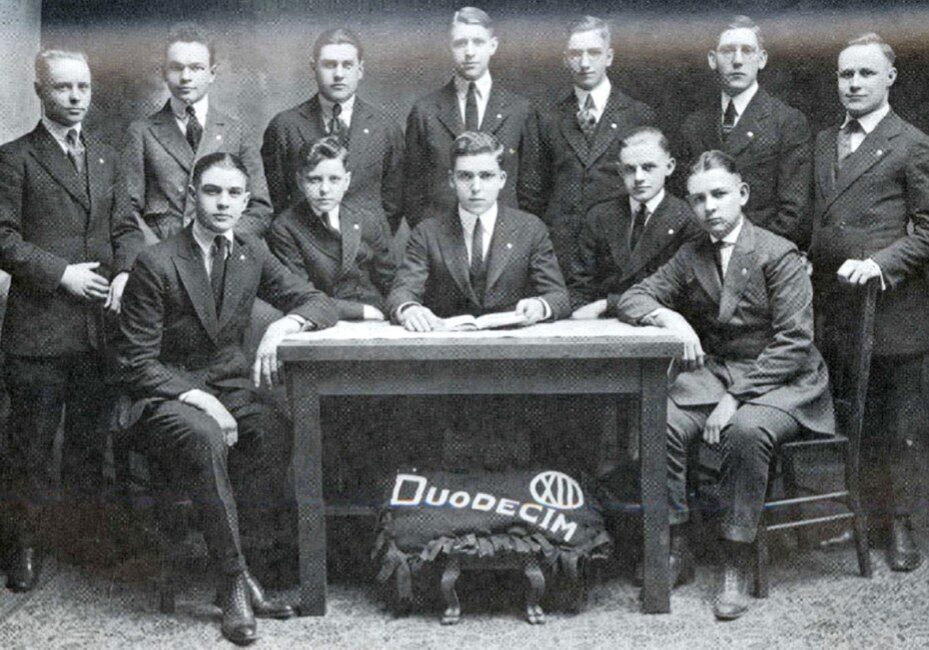Grand Meadow Maintains its Place in History
Decades before Title IX, Grand Meadow’s girls' basketball went undefeated—then lost their right to play at all

GRAND MEADOW — At 106 years old, Beulah Ankeny still has star power. Yet, it floors her that something she did 90 years ago – which she didn’t feel was all that noteworthy at the time – gives her celebrity status in 2025.
Ankeny, then Beulah Travis, was one of the players on the Grand Meadow High School girls’ basketball teams that won 94 straight games from 1929 to 1939, a Minnesota basketball record that will likely never be broken.
The streak wasn’t stopped by a dominant opponent. Instead, a faulty interpretation of women’s physiology ended the amazing run and shut down all competitive girls’ sports in Minnesota for the next 30-plus years.
“It was supposed to be damaging to our reproductive organs. I had six children. I don’t think it did any damage,” said Ankeny with a laugh.
The team started its inaugural season in 1929 with scores such as 65-8 over Lyle, 51-6 over Adams and 52-8 over LeRoy. By the end of the first season, the team had outscored opponents 591-113.
The domination continued for a decade, through the 1930s, with an average winning score of 39-12 through all 10 seasons.

Members of the 1929-30 Grand Meadow High School girls’ basketball team that started the 94-game winning streak include, from left, Madeline McDonough Perry, Mildred Wakefield Olson, Pearl Tommerson Jacobson, Ruth Bratrud Jacobson, Gladys Peterson Fruth, Mildred Berg Gilbert, Phyllis Rother Torgrimson, Marie Tommerson Berg, Gladys Nelson Travis and Helen Gunderson with the ball. (Photo courtesy of Chris Kasak)
The team played other local teams, such as Rose Creek, Kasson, Lime Springs, Elkton, Dover and Peterson and even beat an independent semi-professional team from Mason City.
There are just three trophies in the school’s trophy case from when the team won the Mower Conference League based on season record since no tournament games were allowed for girls’ sports back then.

The 1931-32 trophy was on display at the Minnesota High School Basketball Hall of Fame ceremony in 2018 at the Target Center in Minneapolis. (Photo by Dawn Baudoin)
Well-kept secret for decades
Ankeny, who now lives in Stewartville, is the only player who remains alive from those undefeated Grand Meadow teams. However, the legacy of the team, which was almost forgotten during the decades-long pause in competitive sports for girls, will live on forever as it is such a compelling story.
A streak by Rochester Lourdes High School, which ended with 56 consecutive girls’ basketball wins in the 1991-92 season, revived attention in the extraordinary Grand Meadow record because Lourdes fans figured the team had eclipsed a state record.
However, Marie Berg, a member of the 1929-30 Grand Meadow team, thought to herself, “wait a minute.” Berg, who was still living in the area when she heard about the claims, started drawing attention to the even longer streak 50 years before the one by Lourdes.
Once the word got out about the Grand Meadow record, the recognition soon followed.
The Grand Meadow team was first honored during the sixth annual National Girls and Women in Sports Day on Feb. 6, 1992, at a rally at the state Capitol rotunda.

“Daughters of the Game: The First Era of Minnesota Girls’ High School Basketball, 1891-1942,” by Marian Bemis Johnson and Dorothy E. McIntyre, published by Minnesota Historical Society Press, featured the Grand Meadow High School’s girls’ basketball team.
Berg, who became a physical education teacher in Grand Meadow, was a spokesperson for the team at the rally, according to a book, “Daughters of the Game: The First Era of Minnesota Girls’ High School Basketball, 1891-1942,” by Marian Bemis Johnson and Dorothy E. McIntyre.
“They said the girls weren’t physical enough to stand it, not knowing it didn’t hurt them a bit. We all felt bad when they cut it out. Who knows how long the win streak would have been if that hadn’t happened,” she told the crowd, which included players on the Grand Meadow 1991-92 team, who stood directly behind the honored guests during the ceremony.
The Marie Berg Award for Excellence in Education is now presented annually at the National Girls and Women in Sports Day–Minnesota to outstanding high school teachers or college instructors specializing in physical education, health or exercise science, kinesiology or sport management who, throughout their career, have helped to expand opportunities in sport for girls and women in Minnesota.
In March 2018, the team was among the inaugural group of inductees into the Minnesota High School Basketball Hall of Fame. Ankeny represented the team at the induction ceremony at the Target Center in downtown Minneapolis. An endless stream of well-wishers and young admirers asking for her autograph made their way to her table after the ceremony, which included the induction of Janet Karvonen-Montgomery and Lindsay Whalen as well as Randy Breuer and Kevin McHale.
In October 2019, the team was inducted into the Minnesota State High School League Hall of Fame, which recognizes contributors in all sports.
Also in 2019, the team won the Minnesota Milestone Award given to a program or an individual who has achieved significant milestones in sports equity for girls and women in Minnesota. This legacy award was part of the National Girls and Women in Sports Day – Minnesota.
Ankeny was supposed to attend the legacy program, but the weather was so bad that she declined to navigate the snowy roads. So, Dawn Baudoin, who played basketball at Grand Meadow from 1975 to 1978 and coached the Grand Meadow girls for 21 years in two different stints, the first one starting in 1984-85, accepted the award for the historic team.
Baudoin rode with the current team on a bus to the ceremony. One of those players, Jordan Glynn, is the great-granddaughter of Ankeny’s older sister, Alvena Glynn, who also played on the team during its undefeated stretch.

The team was among the inaugural inductees into the Minnesota High School Basketball Hall of Fame during a 2018 ceremony at Target Center in Minneapolis. (Photo by Dawn Baudoin)
Grand Meadow’s team was undefeated at the time. “I told them they only had something like 70 more games to go to beat the record. That was part of my speech,” said Baudoin.
Recognized again in 2025
Finally, the undefeated team was featured at the Minnesota History Center earlier this year as part of Girlhood (It’s complicated), an exhibit from the Smithsonian’s National Museum of American History and Smithsonian Institution Traveling Exhibition Service. A section on girls’ basketball in Minnesota assembled by the Minnesota Historical Society included an interview with Ankeny.
Baudoin, who took her 1991-92 team to the first recognition at the Capitol and kept going back to the ceremonies, became friends with several of the players, including Ankeny, and did what she could to keep the legacy alive.
“All this happened when there were only a handful of them still living, which is too bad,” said Baudoin. “But the legacy lives on, and I am just so glad that it does.”
Ankeny lives on her own in a townhome in Stewartville. She has a sharp mind as she still plays card games, such as bridge and 500, and gets around well, entertaining occasionally at her home.
Ankeny recalled that she was 10 years old when the winning streak began. She started playing for the team 90 seasons ago this year – 1934-35 – when she was 15. She played one more season as she turned 17 in April 1936 after the 1935-36 season ended, and graduated the following June. When she was younger, she attended country school where she skipped second grade because she was a good student, a common practice in the 1920s.

Dawn Baudoin sits with Beulah Ankeny at her home in Stewartville as she recalls memories from the undefeated teams she was a part of at Grand Meadow High School in the 1930s. (Photo by David Phillips)
It was a different world back then as the team’s win streak roughly correlated with the Great Depression. One of the attractions of basketball, said Ankeny, was that there was little else to do with no television, limited money for entertainment and no paved roads to get around. Highway 16 was just starting to be built alongside her family home when she turned 10.
Different game 90 years ago
Basketball was also much different then. The game had a two-court format, the same as in Iowa, where girls couldn’t cross the center line and three girls stayed in each half of the court. Players were allowed three dribbles and then had to pass the ball. That meant some girls only played defense, never getting a chance to shoot, and others only played offense.
When the program started, girls had to arrange their own transportation with parents because they weren’t allowed on the buses with the boys’ team. They also were on their own after practices, which meant some of the girls who lived in the country walked up to two miles to get home, occasionally contending with winter snowstorms.
The school issued purple, wool shorts, which lasted all the years of the program and were only sent to the cleaners at the end of each season so they were fresh for the start of the next year, noted Ankeny. Mothers of the players made blouses to wear during games.
“That was Depression days, you know,” said Ankeny. “There wasn’t much money. We had to make do.”
They practiced in the school gymnasium, but played games in the opera house, which has since burned down. They had to dress at the school and then run down the alley to the opera house in their shorts during the dead of winter to play in games.
The opera house had a court painted on the floor and baskets with backboards, but it was a multi-use facility that also had everything from dances and movies to poultry shows and graduation exercises.
The boys also played at the opera house after the girls’ games. The girls always drew good crowds, and, as their streak snowballed, they often had a full house watch their games with many fans departing before or during the boys’ games, according to team members.
There is a photo of a Grand Meadow girls’ basketball team with five players in 1911, but as far as anyone knows, the team was formed in 1929 when an English teacher named Lila Reiersgard, who grew up in Ulen, Minn., and graduated from Concordia College in Moorhead, became coach, staying on for the first seven years of the program.
Ankeny remembers the coach had tough practices several times a week, one of the few teams at the time that had regular practices. Although team members said she wasn’t too athletic-looking and she was quiet, the girls respected her while she emphasized preparation and defense in her practices, a foundation that proved successful.
Ankeny, who regularly watches the Minnesota Lynx, said she is amazed at how much women’s basketball has changed with the speed of the game, conditioning of the players and the shooting skills on display.
“Goodness, if they saw us, they would just laugh” with all the restrictions of the center court line and number of dribbles, she said.
Grand Meadow story part of societal trend
Co-authors Johnson and McIntyre said there were as many as 300 teams playing in Minnesota in the 1930s, although Ankeny recalled that many of the larger schools, such as Rochester, Spring Valley, Stewartville and Austin, didn’t have teams.
The co-authors noted that throughout the 1930s, there was a movement to end interscholastic basketball for girls across the state and nation. Their book states that in 1933, the president of the American Physical Education Association wrote that the stimulation of a cheering crowd and band, when added to the emotional and physical strain of sports, could upset the endocrine balance in young females.
In 1938, Grand Meadow, like all schools that still had girls’ basketball programs, received a letter from the state education department ordering schools to replace competitive athletics for girls with intramural sports.
The Grand Meadow girls received no explanation when they were told the program ended after the 1938-39 season. They were invited to become cheerleaders for the boys’ team, but they declined.
“We were told that it was state law that we couldn’t play,” Mae Gross told the book authors. “We were sick, we were angry. But, we were in that age when we still were expected to respect decisions. The state said, ‘That’s it,’ and we didn’t think there was any choice but to accept it.”

Beulah Ankeny, left, and Mae Gross in the Grand Meadow High School gym in the 1990s when the Minneapolis Star Tribune did a story on the team. (Photo courtesy of Dawn Baudoin)
For the next 30-plus years, high school girls in Minnesota learned how to play sports in gym class, but couldn’t take part in competition with other organized teams. It wasn’t until the 1970s, especially after Title IX was enacted in 1972, that girls’ basketball was resurrected.
As enthusiasm for the sport grew in the modern era, the roots of girls’ basketball came to the forefront, and with it, the emphasis on the amazing record of the Grand Meadow team.
Ankeny recalled her sister calling her before she had any idea about the historic nature of the streak, asking her, “How would you like to be in the Hall of Fame? ‘Hall of Fame,?’ I said, I never heard of anything so ridiculous in my life. Who would have thought a little person like me would be in the Hall of Fame?”
Soon, the legendary status of the team expanded and the role of celebrity became routine for Ankeny. Still, she keeps her unexpected fame in perspective.
“I don’t let it go to my head,” she said. “I was glad I was a part of it, but I feel bad that the rest of them couldn’t share in it.”






